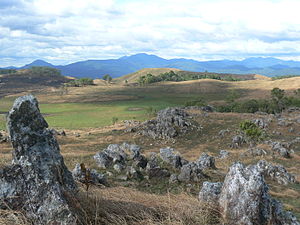Southeastern Indochina dry evergreen forests
The Southeastern Indochina dry evergreen forests are a tropical dry broadleaf forest ecoregion of Indochina.
| Southeastern Indochina dry evergreen forests | |
|---|---|
 Virachey National Park in northeast Cambodia | |
 Ecoregion territory (in purple) | |
| Ecology | |
| Realm | Indomalayan |
| Biome | tropical and subtropical dry broadleaf forests |
| Borders | List
|
| Geography | |
| Area | 123,778 km2 (47,791 sq mi) |
| Countries | Cambodia, Laos, Thailand, and Vietnam |
| Conservation | |
| Conservation status | vulnerable |
| Protected | 28,210 km² (23%)[1] |
Setting
The ecoregion covers an area of 124,300 square kilometers (48,000 sq mi), extending across portions of Cambodia, Laos, Thailand, and Vietnam.
The Southeastern Indochina dry evergreen forests occupy the lower portion of the Mekong Basin, where they are intertwined with the Central Indochina dry forests. The Southern Annamites montane rain forests border the dry evergreen forests on the east, occupying the higher elevations of the Annamite Range. To the south, the Indochina mangroves lie between tropical seasonal forests and the South China Sea. The Tonle Sap-Mekong peat swamp forests and Tonle Sap freshwater swamp forests lie to the southeast, in the seasonally and permanently flooded lowlands along the Tonle Sap and lower Mekong rivers and Tonle Sap Lake.
Flora
The Southeastern Indochina dry evergreen forests are one of three dry broadleaf forest ecoregions with predominantly evergreen trees; trees in dry broadleaf forests typically lose their leaves during the dry season.
Fauna
The ecoregion is home to many large mammals, including the Asian elephant (Elephas maximus), tiger (Panthera tigris), previously one of two known populations of the now extinct Javan rhinoceros (Rhinoceros sondaicus annamiticus), Eld's Deer (Cervus eldi), banteng (Bos javanicus), gaur (Bos gaurus), clouded leopard (Pardofelis nebulosa), leopard (Panthera pardus), Malayan sun bear (Ursus malayanus), and khting-vor (Pseudonovibos spiralis).[2]
Conservation
A 2017 assessment found that 28,210 km², or 23%, of the ecoregion is in protected areas. Another 23% is forested but outside protected areas.[3]
External links
- "Southeastern Indochina dry evergreen forests". Terrestrial Ecoregions. World Wildlife Fund.
- World Wildlife Fund, ed. (2001). "Southeastern Indochina dry evergreen forests". WildWorld Ecoregion Profile. National Geographic Society. Archived from the original on 2010-03-08.
References
- Eric Dinerstein, David Olson, et al. (2017). An Ecoregion-Based Approach to Protecting Half the Terrestrial Realm, BioScience, Volume 67, Issue 6, June 2017, Pages 534–545; Supplemental material 2 table S1b.
- "Southeastern Indochina dry evergreen forests". Terrestrial Ecoregions. World Wildlife Fund.
- Eric Dinerstein, David Olson, et al. (2017). An Ecoregion-Based Approach to Protecting Half the Terrestrial Realm, BioScience, Volume 67, Issue 6, June 2017, Pages 534–545; Supplemental material 2 table S1b.